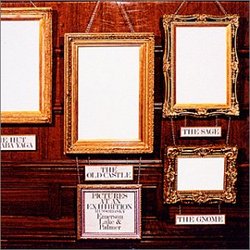Erratic execution mars ambitious concept
Eddie Konczal | 05/18/2005
(2 out of 5 stars)
"With virtuoso keyboardist Keith Emerson at the helm, progressive rock supergroup Emerson Lake & Palmer specialized in adapting classical music to the rock form. Their 1971 debut featured adaptations of works like Bartok's "The Barbarian" and Janacek's "Sinfonietta" (re-titled "Knife-Edge"). "Pictures at an Exhibition" (1972), the first of three live albums ELP released during the 1970s, represented an ambitious leap from these shorter attempts. Most of the album's running time is devoted to ELP's interpretation of Russian composer Modest Mussorgsky's work of the same name. The encore "Nutrocker," a takeoff on Tchaikovsky's "Nutcracker" theme, brings the album to full LP running time.
To some extent, all ELP live albums suffer from the same limitation: they fail to convey the spectacle of the band in concert. ELP shows featured pyrotechnics, fireworks, knife-throwing, and a variety of other visual treats that don't translate to record. While these stage antics enhanced the experience for those present, they occasionally hampered the band's ability to deliver the solid performances required for great recordings. Later live albums like "Welcome Back My Friends To The Show That Never Ends..." circumvented this problem by cherry-picking the best tracks from various shows. However, the long-form nature of "Pictures at an Exhibition" made it difficult to gloss over the dodgy bits.
There are unquestionably moments of greatness, but not enough to prevent all but the most diehard ELP fans from resorting to the Fast Forward button. The intro and its reprise ("Promenade") and finale ("The Great Gates of Kiev") are appropriately majestic, and Greg Lake delivers a lovely vocal performance on "The Sage." "The Hut of Baba Yaga" brilliantly showcases ELP's kinetic fury. Beyond that, there's way too much bluff: unfocused synthesizer noodling (on "The Gnome," "The Old Castle," and "The Curse of Baba Yaga"), meandering blues jams ("Blues Variations"), and Emerson's obligatory wrestling match with his organ, which delighted the audience but disrupts the grandeur of the finale.
Rock purists and classical aficionados alike excoriated "Pictures" for daring to merge the two genres. Such criticism represents the height of snobbery. The real problem is that with a work of this ambition, there's little margin for error. Unfortunately, ELP's desire to please the crowd left them with a highly erratic recording, unworthy of the lofty goals they sought to achieve.
ELP would go on to fine-tune and arguably improve their interpretation of Mussorgsky's work. Check out the underrated "Works Live" for a condensed, more focused version of "Pictures," or the highly polished, stately version from the 4-CD boxed set, "Return of the Manticore." While this record is a must-own for diehard fans, newcomers to the world of ELP should approach the original "Pictures" with caution."
ELP dish out a little Mussorgsky in a live concert
Lawrance M. Bernabo | The Zenith City, Duluth, Minnesota | 01/09/2003
(4 out of 5 stars)
"Of course part of the sheer audacity of Emerson, Lake & Palmer's performance of Modest Mussorgsky's "Pictures at an Exhibition" was that they did in live at Newcastle City Hall, March 26, 1971. But while I appreciate the raw vitality of the performance I always wonder what the lads could have done if they had gone into the studio and polished this one up a bit like they did on some of their later albums with works by Aaron Copeland. Of course, Mussorgsky originally wrote the piece for the piano, before Ravel turned it into an orchestral piece, so it is pretty much an ideal choice for Keith Emerson to do on the piano, synthesizer, and every other key board instrument in the known universe that he could get his fast little fingers on. Emerson did the overall arranging but each of the premier progressive rock trio have a hand in adapting certain segments to their particular fortes (e.g., drummer Carl Palmer on "The Gnome"). Greg Lake even manages to find a few places for some lyrics. The evening is capped off by the "Nutrocker," one of the group's favorite encore pieces (but by a different Russian composer than Mussorgsky). Ultimately, "Pictures at an Exhibition" does not stand up against the group's own efforts such as the Tarkus suite, "Karn Evil No. 9," or "Pirates." This is the ELP album I listen to the least, but every once in a while there comes a time when you need to listen to a little "Pictures at an Exhibition. The bonus track on this Import album is a bit redundant and repetitive, but it does offer up something extra for picking up this remastered disk."

